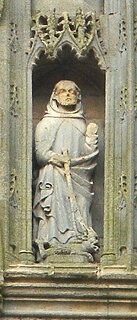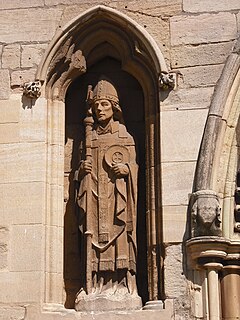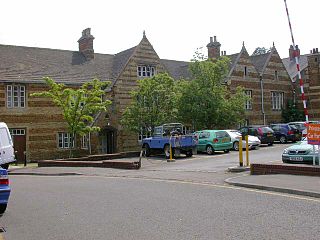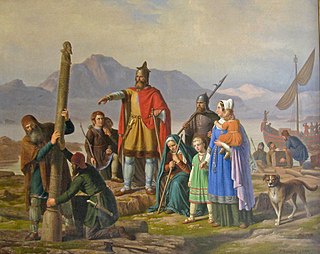This page is based on this
Wikipedia article Text is available under the
CC BY-SA 4.0 license; additional terms may apply.
Images, videos and audio are available under their respective licenses.

Year 1120 (MCXX) was a leap year starting on Thursday of the Julian calendar.

Crowland or Croyland is a small town in the
South Holland district of Lincolnshire, England. It is situated between Peterborough and Spalding. Crowland contains two sites of historical interest, Crowland Abbey and Trinity Bridge

The Croyland or Crowland Chronicle is an important primary source for English medieval history, particularly the late 15th century. It is named for its place of origin, the Benedictine Abbey of Croyland or Crowland, in Lincolnshire, England. It was formerly also known as the Chronicle of Ingulf or Ingulphus after its supposed original compiler, the 11th-century abbot Ingulf. As that section of the text is now known to have been a later forgery, its author is instead known as Pseudo-Ingulf.

Saint Guthlac of Crowland was a Christian saint from Lincolnshire in England. He is particularly venerated in the Fens of eastern England.
Congé d'élire is a licence from the Crown in England issued under the great seal to the dean and chapter of the cathedral church of a diocese, authorizing them to elect a bishop or archbishop, as the case may be, upon the vacancy of any episcopal see in England.

Saint Wulfram of Fontenelle or Saint Wulfram of Sens was the Archbishop of Sens. His life was recorded eleven years after he died by the monk Jonas of Fontenelle. However, there seems to be little consensus about the precise dates of most events whether during his life or post mortem.

Crowland Abbey is a Church of England parish church, formerly part of a Benedictine abbey church, in Crowland in the English county of Lincolnshire. It is a Grade I listed building.

Croyland Abbey is a Grade II-listed manor house, in Wellingborough, Northamptonshire.
William of Ramsey was a 13th-century English Benedictine monk of Croyland Abbey, born at Ramsey, Huntingdonshire.

Thurcytel was abbot of Crowland and perhaps also of Bedford Abbey.
The Abbot of Crowland was the head of Crowland Abbey, an English monastery built up around the shrine of Saint Guthlac of Crowland by King Æthelbald of Mercia, and refounded as a Benedictine house circa 948. The last abbot was John Wells, who handed the monastery over to The Crown and dissolution in 1539.
Bedford Abbey was a short-lived Benedictine monastery, recorded in 10th century England. Bedford Priory, perhaps representing the same institution two centuries later, was an Augustinian priory that within two decades of its foundation moved to nearby Newnham.
Cissa of Crowland was a saint in the medieval Fenlands. He was the successor of Guthlac as abbot of Crowland, and is mentioned in Felix' Vita Guthlaci. According to the Crowland Chronicle his tomb was next to Guthlac's, and like the tomb of Guthlac, was destroyed by the Scandinavians. His relics were translated to Thorney Abbey in the 10th-century.
Waltheof of Allerdale was an 11th- and 12th-century Anglo-Saxon noble, lord of Allerdale in modern Cumbria. Brother of Dolfin of Carlisle and Gospatric of Dunbar, Waltheof was son of Gospatric, Earl of Northumbria. Both Waltheof and his brother Gospatric witness Earl David's Glasgow Inquest 1113 x 1124, and Waltheof also attests some of David's charters as king of the Scots later. The account of Waltheof and his family in Cumbrian monastic cartularies, says that he gave land in Allerdale to his three sisters, Octreda, Gunhilda and Maud.

Saints Tancred, Torthred, and Tova were three Anglo-Saxon siblings who were saints, hermits and martyrs of the Ninth century. Their feast day was celebrated on 30 September at Thorney and Deeping.
The Peterborough Psalter is a name given to two different illuminated manuscripts of the Psalms produced in the scriptorium of Peterborough Abbey. One, from the early 13th century, is now in the Fitzwilliam Museum, Cambridge; the other, from the early 14th century, in the Royal Library of Belgium.

The Historia Croylandensis is a series of bound documents, allegedly from the 15th century, containing a fake history of the Benedictine abbey of Croyland in Lincolnshire, England.








